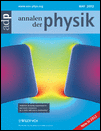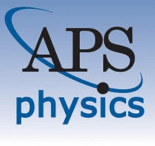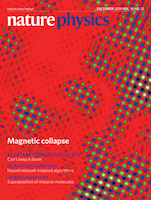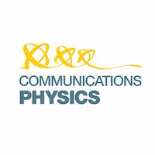
ANNALEN DER PHYSIK
Scope & Guideline
Illuminating Innovative Research Since 1799
Introduction
Aims and Scopes
- Quantum Mechanics and Quantum Information:
Research articles often delve into quantum correlation, entanglement, quantum teleportation, and quantum state manipulation, highlighting the journal's dedication to advancing quantum information science. - Optics and Photonics:
A significant number of publications focus on optical phenomena, including light-matter interactions, optical vortex beams, and metamaterials, reflecting the journal's emphasis on the latest advancements in optics and photonics technologies. - Condensed Matter Physics:
The journal frequently features studies related to superconductivity, magnetism, and topological materials, showcasing its commitment to exploring the properties of condensed matter systems. - Gravitational Physics and Cosmology:
Articles often investigate gravitational waves, black hole physics, and cosmological models, indicating a strong interest in fundamental questions about the universe. - Metamaterials and Nanophotonics:
Research in this area explores novel materials and their applications in manipulating electromagnetic waves, demonstrating the journal's focus on cutting-edge technology and material science. - Statistical Physics and Complex Systems:
The journal includes studies on statistical mechanics, phase transitions, and complex networks, illustrating its breadth in addressing fundamental and applied aspects of physics.
Trending and Emerging
- Quantum Technologies and Quantum Computing:
There is a growing trend towards research in quantum computing, including advancements in quantum algorithms, error correction, and quantum simulations, signaling a vibrant interest in harnessing quantum mechanics for practical applications. - Topological Phases and Materials:
An increasing number of articles explore topological materials and phases, revealing a burgeoning interest in their unique properties and potential applications in electronics and quantum computing. - Non-Hermitian Physics:
Research in non-Hermitian systems is on the rise, with studies focusing on phenomena such as exceptional points and their implications for quantum mechanics and optics, indicating a fresh area of exploration within the field. - Optomechanics and Hybrid Systems:
There is a notable increase in studies involving optomechanical systems and their integration with other quantum systems, showcasing the journal's emphasis on innovative approaches to quantum control and measurement. - Artificial Intelligence in Physics Research:
Emerging themes include the application of machine learning and AI techniques to address complex problems in physics, demonstrating a trend towards interdisciplinary research that leverages computational advancements.
Declining or Waning
- Classical Mechanics:
There has been a noticeable decrease in publications related to classical mechanics, suggesting a shift towards more modern and complex theories that better address contemporary physics challenges. - Thermodynamics and Statistical Mechanics:
Although still relevant, the frequency of papers specifically dedicated to classical thermodynamics has diminished, possibly due to the growing focus on quantum statistical effects and non-equilibrium systems. - Fundamental Particle Physics:
Research articles centered on traditional particle physics have become less common, as the field increasingly intersects with cosmology and high-energy phenomena, indicating a potential evolution in the focus of theoretical investigations.
Similar Journals

PHYSICAL REVIEW LETTERS
Showcasing Transformative Research in Real-TimePhysical Review Letters, published by the American Physical Society, is a premier journal in the field of Physics and Astronomy renowned for its rapid dissemination of high-impact research findings. With a distinguished history dating back to 1958 and an impressive ranking of #13 out of 243 in the general physics category, it stands proudly within the Q1 quartile, placing it in the top 6% of journals in its field. The journal focuses on brief reports of significant fundamental research across all areas of physics, making it an essential resource for researchers, professionals, and students seeking to stay at the forefront of developments in their field. Although Physical Review Letters does not offer open access options, its rigorous peer-review process ensures a high standard of quality and relevance in its published articles. With an unwavering commitment to advancing the understanding of physical science, this journal is indispensable for those looking to make a genuine impact in their research endeavors.

PHYSICAL REVIEW A
Exploring the Frontiers of Atomic and Molecular PhysicsPHYSICAL REVIEW A, published by the American Physical Society, is a leading journal in the field of Atomic and Molecular Physics and Optics, boasting a Q1 category ranking in its area for 2023. With an ISSN of 2469-9926 and an E-ISSN of 2469-9934, this journal plays a pivotal role in disseminating high-quality research findings, theories, and methodologies that shape current understanding and advancements in the discipline. Although not an open-access journal, it remains highly accessible to professionals and academia through institutional subscriptions. The journal's impactful contributions are evident from its Scopus rank of #70 out of 224 in the field, placing it in the 68th percentile for scholarly impact. As a hub of innovative research and a vital resource for both students and seasoned researchers alike, PHYSICAL REVIEW A remains essential for those seeking to stay abreast of breakthroughs in atomic and molecular studies, as well as optics and photonics.

Nature Physics
Advancing Knowledge in the Heart of PhysicsNature Physics is a premier journal dedicated to publishing high-impact research in the realm of physics, brought to you by the esteemed NATURE PORTFOLIO. With its ISSN 1745-2473 and E-ISSN 1745-2481, this journal has established itself as a vital resource for the physics community, enjoying a remarkable Q1 quartile ranking in the Physics and Astronomy category for 2023 and securing an impressive Rank #5/243 and a 98th percentile ranking in Scopus. Since its inception in 2005, Nature Physics has become a catalyst for innovation, featuring cutting-edge research that encompasses a broad spectrum of physics disciplines. Although it operates under traditional subscription models, it maintains a commitment to accessibility through selective publications and editorial excellence. Positioned in Berlin, Germany, this journal is a must-read for researchers, professionals, and students who seek to stay at the forefront of advancements in physics.

Communications Physics
Catalyzing discoveries in the realm of Physics and Astronomy.Communications Physics is a premier open access journal published by Nature Portfolio, dedicated to disseminating high-quality research in the field of Physics and Astronomy. Since its inception in 2018, the journal has rapidly established itself as a vital platform for innovative scientific communication, boasting an impressive Impact Factor and achieving Q1 status in the 2023 category of Physics and Astronomy (miscellaneous). With a Scopus rank of #31 out of 243, placing it within the 87th percentile, Communications Physics attracts a global audience of researchers, professionals, and students eager to engage with cutting-edge findings. The journal supports open access, ensuring that research is freely available to the public, which enhances its visibility and encourages broader discussions within the scientific community. Located in Berlin, Germany, Communications Physics aims to bridge the gap between various disciplines within physics, fostering interdisciplinary collaboration and inspiring future research endeavors.

Science China-Physics Mechanics & Astronomy
Shaping the Future of Physics and Astronomy ResearchScience China-Physics Mechanics & Astronomy, published by SCIENCE PRESS, stands as a prestigious journal within the Physics and Astronomy domain, particularly recognized for its contributions to the understanding of fundamental and applied physics. With an exhilarating Q1 ranking in the 2023 category and earning a remarkable scopus rank of #21 out of 243, the journal demonstrates its significant impact, being positioned in the 91st percentile of its field. Operating under an Open Access model, it facilitates the broad dissemination of high-quality research, ensuring accessibility for researchers, professionals, and students worldwide. Its scope covers a variety of essential topics in physics and astronomy, promoting a comprehensive understanding of the latest advancements from 2010 through 2024. The journal is a vital resource for anyone aiming to stay at the forefront of research in these dynamic fields, with its prominent address located in Beijing, China, symbolizing its global influence.

ANNALES HENRI POINCARE
Unlocking Complex Phenomena Through Rigorous ResearchANNALES HENRI POINCARE is a prestigious journal published by Springer International Publishing AG, dedicated to advancing research in the fields of Mathematical Physics, Nuclear and High Energy Physics, and Statistical and Nonlinear Physics. With an impressive Q1 ranking in its respective categories as of 2023, this journal is recognized as a vital resource for academic researchers, professionals, and students engaged in frontier studies of theoretical and applied physics. The journal's commitment to high-quality peer-reviewed articles promotes significant contributions to the understanding of complex physical phenomena, making it essential reading for anyone seeking to stay abreast of developments in these dynamic fields. Additionally, ANNALES HENRI POINCARE offers open access options to enhance the visibility and accessibility of groundbreaking research, underscoring its role in fostering collaborative scientific inquiry and innovation. Since its inception in 2000, it has continually provided a platform for scholars worldwide to disseminate their findings and engage with the broader scientific community, thus establishing itself as a cornerstone of academic literature.

PHYSICAL REVIEW D
Catalyzing Insights in Physics and AstronomyPHYSICAL REVIEW D, published by the American Physical Society, is a premier journal dedicated to the rapid dissemination of significant research findings in the fields of Nuclear and High Energy Physics as well as Physics and Astronomy. With an impressive Impact Factor and a prestigious Q1 ranking in 2023, it stands as one of the leading journals in its domain, with a Scopus ranking of #6 out of 87 in its category, placing it in the 93rd percentile. The journal welcomes rigorous theoretical and experimental studies that advance understandings in particle physics, cosmology, and quantum field theory. Although it does not provide open access, researchers gain a significant platform to reach a global audience and contribute to the ongoing discourse within the scientific community. Published regularly since its convergence starting in 1989, it remains essential for both emerging and established scholars looking to stay at the forefront of high-energy and nuclear physics research.

Frontiers of Physics
Exploring New Horizons in Physics InnovationFrontiers of Physics, published by Higher Education Press, is a premier open-access journal dedicated to fostering innovative research and excellence within the field of physics. With an ISSN of 2095-0462 and an E-ISSN of 2095-0470, this rapidly growing journal has established itself as a valuable platform for disseminating cutting-edge findings, covering a diverse range of topics from theoretical frameworks to experimental advancements. Notably, Frontiers of Physics has achieved an impressive Q1 ranking in the 2023 Scopus Quartiles for Physics and Astronomy, securing a competitive 5th out of 81 positions in its category, reflecting a high impact factor that underscores its importance to the scientific community. Since its inception in 2011 and continuing through 2024, the journal aims to bridge the gap between academia and industry, encouraging collaboration among researchers, professionals, and students alike. Its commitment to open access ensures that high-quality research is readily accessible, thereby promoting knowledge sharing and advancement in the global physics community. Explore the potential of your research in Frontiers of Physics, where the future of physics flourishes.

CHINESE PHYSICS LETTERS
Pioneering New Horizons in Physics KnowledgeChinese Physics Letters is a prestigious journal published by IOP Publishing Ltd, based in the United Kingdom. Since its inception in 1984, the journal has served as a vital platform for disseminating impactful research in the field of physics, achieving a noteworthy Q1 ranking in the category of Physics and Astronomy (miscellaneous) as of 2023. Renowned for its rapid publication process, this journal is dedicated to providing a forum for high-quality, concise articles that address innovative theoretical and experimental findings relevant to both the academic community and industry practitioners. With an impressive Scopus rank of #52 out of 243, placing it in the 78th percentile, Chinese Physics Letters continues to influence the global physics landscape. Researchers, professionals, and students alike find this journal indispensable for staying abreast of the latest developments and trends in physics.

Physical Review Research
Fostering collaboration in cutting-edge scientific discovery.Physical Review Research, published by the American Physical Society, is a premier open access journal dedicated to the dissemination of high-quality research across all areas of physics and astronomy. Since its inception in 2019, this journal has quickly established itself as a vital platform for researchers, achieving a prestigious Q1 ranking in the dynamics of Physics and Astronomy (miscellaneous) and holding a commendable position in the Scopus Rankings with a rank of #29 out of 243, placing it in the 88th percentile. With the commitment to fostering scientific collaboration and transparency, Physical Review Research offers unrestricted access to valuable findings, enabling researchers, professionals, and students alike to engage with cutting-edge contributions in general physics and astronomy. As it converges into its forthcoming years of publication, the journal remains dedicated to showcasing rigorous research and innovative ideas that drive the field forward.